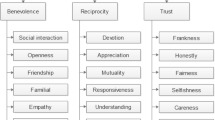Abstract
The development of the Primary Care Patient Request Scale and factor analytic and validation data from four diverse clinic samples are reported. The factor analysis yielded five plausible request dimensions: Treatment of Psychosocial Problems, Medical Explanation, Supportive Communication, Test Results, and Ventilation and Legitimation. The construct validity of the instrument was tentatively supported by the ability of the factor scales to discriminate consistently among the nature of the presenting complaint, the type of primary care clinic, and the marital status of the patient. Establishment of the clinical and research utility of the Primary Care Patient Request Scale awaits further efforts at cross-validation.
Similar content being viewed by others
References
Balint, M. (1965). The doctor's therapeutic function.Lancet June 5: 1177–1180.
Barsky, A. J. (1981). Hidden reasons patients visit doctors.Ann. Intern. Meet. 94: 492–498.
Brody, D. S. (1980). Patients' role in clinical decision-making.Ann Intern. Med. 93: 718–722.
Eisenberg, L. (1977). Disease and illness: Distinctions between professional and popular ideas of sickness.Cult. Med. Psychiat. 1: 9–24.
Fink, R., Goldensohn, S., Shapiro, S., and Daily, E. (1967). Treatment of patients designated by family doctors as having emotional problems.Am. J. Public Health 57: 1550–1564.
Fischer, E., Winer, D., and Abramowitz, S. I. (1983). Seeking professional help for psychological problems. In DePaulo, B., Nadler, A., and Fischer, J. (eds.),New Directions in Helping, Vol. 3: Applied Perspectives on Help Seeking and Receiving. Academic Press, New York (in press).
Frank, A., Eisenthal, S., and Lazare, A. (1978). Are there social class differences in patients' treatment conceptions?Arch. Gen. Psychiat. 35: 61–69.
Good, B., and Good, M. (1981). The meaning of symptoms: A cultural hermeneutic model for clinical practice. In Eisenberg, L., and Kleinman, A. (eds.),The Relevance of Social Science for Medicine, Reidel, Boston.
Good, M., and Good, B. (1982). Patient requests in primary care. In Chrisman, N., and Maretzki, T. (eds.),Clinically Applied Anthropology, Reidel, Boston.
Hankin, J., and Oktay, J. S. (1979).Mental disorder and primary medical care: An analytical review of the literature. NIMH Monograph Series D, No. 5, Department of Health, Education and Welfare Publication No. 78-661, U.S. Government Printing Office, Washington, D.C.
Houpt, J. L., Orleans, C. S., George, L. K., and Brodie, H. K. H. (1979).The Importance of Mental Health Service to General Health Care, Ballinger, Cambridge, Mass.
Katon, W., and Kleinman, A. (1981). Doctor-patient negotiation and other social science strategies in patient care. In Eisenberg, L., and Kleinman, A. (eds.),The Relevance of Social Science for Medicine, Reidel, Boston.
Katon, W., Kleinman, A., and Rosen, G. (1983). Depression and somatization: A review.Am. J. Med. (in press).
Kleinman, A., Eisenberg, L., and Good, B. (1978). Culture, illness and care: Clinical lessons from anthropological and cross-cultural research.Ann. Intern. Med. 88: 257–258.
Lazare, A., and Eisenthal, S. (1977). Patient requests in a walk-in clinic.J. Nerv. Ment. Dis. 165: 330–340.
Lazare, A., Eisenthal, S., and Wasserman, L. (1975a). The customer approach to patienthood.Arch. Gen. Psychiat. 32: 553–558.
Lazare, A., Eisenthal, S., Wasserman, L., and Hartford, T. C. (1975b). Patient requests in a walk-in clinic.Compr. Psychiat. 16: 467–477.
Levinson, S., Merrifield, J., and Berg, K. (1967). Becoming a patient.Arch. Gen. Psychiat. 17: 385–406.
Marcus, A. C., and Seeman, T. E. (1981). Sex differences in reports of illness and disability: A preliminary test of the “fixed role obligations” hypothesis.J. Health Soc. Behav. 22: 174–182.
Marcus, A. C., and Siegel, J. M. (1982). Sex differences in the use of physician services: A preliminary test of the fixed role hypothesis.J. Health Soc. Behav. 23: 186–197.
McWhinney, I. R. (1972). Beyond diagnosis.N. Engl. J. Med. 287: 384–387.
Pilowsky, I. (1969). Abnormal illness behavior.Br. J. Med. Psychol. 42: 347–351.
Rosenfield, S. (1980). Sex differences in depression: Do women always have higher rates?J. Health Soc. Behav. 21: 33–42.
Stewart, M., McWhinney, I. R., and Buch, C. W. (1975). How illness presents: A study in patient behavior.J. Fam. Pract. 2: 411–414.
Stiles, W. B., Putnam, S. M., Wolf, M. H., and Jones, S. A. (1979). Interaction exchange structure and patient satisfaction with medical interview.Med. Care 17: 667–681.
Stumbo, D., Good, M. J. D., and Good, B. J. (1982). Diagnostic profile of a family practice clinic: Patients with psychosocial diagnoses.J. Fam. Pract. 14: 281–285.
Style, A., Rafferty, E., and Kelley, M. (1980). The patient's hidden agenda.J. Fam. Pract. 11: 635–640.
Waitzkin, H., and Stoeckle, J. D. (1972). The cummunication of information about illness.Adv. Psychosom. Med. 8: 180–215.
Wolf, M. H., Putnam, S. M., James, S. A., and Stiles, W. B. (1978). The medical interview satisfaction scale: Development of a scale to measure patient perceptions of physician behavior.J. Behav. Med. 1: 391–401.
Author information
Authors and Affiliations
Additional information
This research was funded by a California Policy Award from the Department of Governmental Studies, University of California, Berkeley, and by National Institute of Mental Health Grant 16463.
The authors wish to thank researchers Diane Stumbo, Sandra Gifford, and James Cooper for their assistance in data collection, Dr. Steve Abramowitz for critical comments on an early draft of this article, and the patients and physicians for their generous participation.
Rights and permissions
About this article
Cite this article
DelVecchio Good, M.J., Good, B.J. & Nassi, A.J. Patient requests in primary health care settings: Development and validation of a research instrument. J Behav Med 6, 151–168 (1983). https://doi.org/10.1007/BF00845378
Accepted:
Issue Date:
DOI: https://doi.org/10.1007/BF00845378



